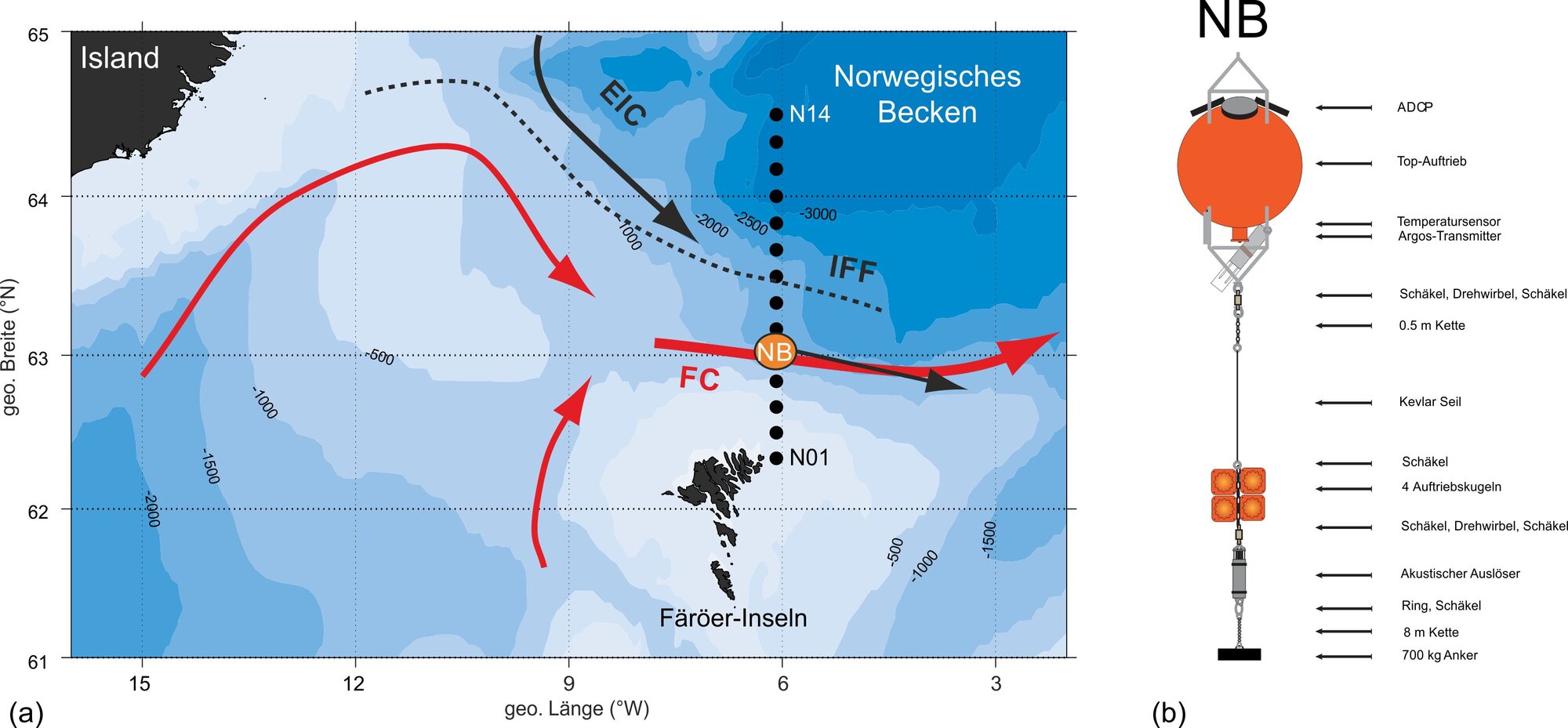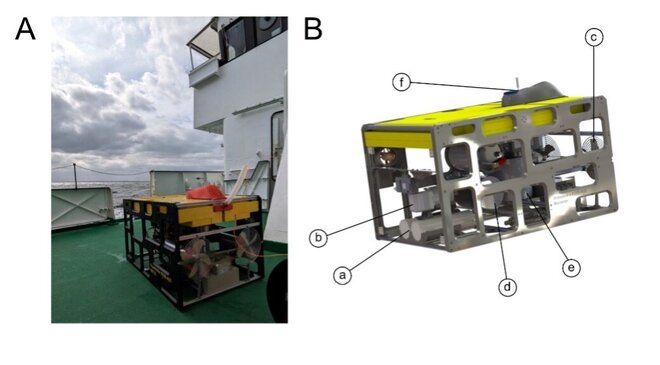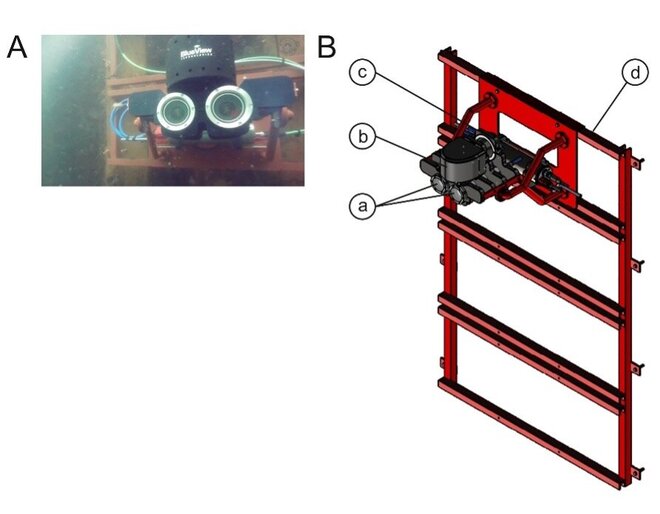Project
Development of physical measurement methods for non-invasive in-situ detection of plankton and fish

Within the scope of this project, hydroacoustic and optical instruments and methods will be used jointly and further developed to enable the continuous, automated, hogh-resolution and non-invasive recording of marine organisms in their natural environment. Furthermore, we aim to extend the understanding of the functional relationships of organisms of different trophic levels (e.g. fish and zooplankton) as well as potential behavioural patterns such as the vertical migration of individual species.
Background and Objective
The aim of the project is to use hydroacoustic and optical methods to enable continuous, automated, high-resolution, and non-invasive observation of marine organisms in their natural environment. Optical and acoustic techniques can be used independently or be coupled to replace or complement conventional net sampling. Both non-invasive approaches can be applied in diverse environments, providing high spatial and temporal resolution.
Acoustic methods using relatively low frequencies (38–200 kHz) are advantageous for detecting fish and zooplankton at moderate distances (tens to hundreds of meters), sampling large water volumes. Higher frequencies in the range of several hundred kHz to MHz can produce high-resolution acoustic images and detect backscatter from small zooplankton species. On the other hand, optical methods allow for the clear differentiation and identification of organisms such as fish and zooplankton.
At the Thünen Institute, in-situ non-invasive observation instruments are mounted on various stationary and mobile platforms. Autonomous data processing methods are being further developed to combine the advantages of both optical and acoustic measurement systems and provide a more holistic view of the ecosystem.
Target Group
Policy makers, marine and fisheries scientists
Approach
A detailed characterization of marine ecosystems with a detailed taxonomic differentiation, remains challenging when relying solely on hydroacoustic data. This limitation can be compensated through the integration of alternative biological information. Conversely, optical data alone provides only limited quantitative information, due to the limited sampling volume. Since both acoustic and optical monitoring systems have unique advantages and limitations, several studies have coupled both methods to take use the best of both worlds and gain a more complete picture of the observed ecosystem.
At the Thünen Institute, various camera and sonar systems are commonly used, either individually or in combination, for continuous, partly automated, high-resolution, and non-invasive observations of marine ecosystems. Some of these systems are presented in the following section.
Our Research Questions
- How can optical and hydroacoustic technologies and their analytical methods be best combined and further developed, to enable automated, non-invasive, and high-resolution (space and time) monitoring of marine ecosystems?
- How can we improve hydroacoustic and optical measurement methods and the quality of the resulting data?
Preliminary Results
Publications in international journals Presentations and publications in the framework of different ICES expert groups, e.g., Working Group on Operational Oceanographic Products for Fisheries and Environment (WGOOFE), Working Group on Fisheries Acoustics, Science and Technology (WGFAST), Working Group on International Pelagic Surveys (WGIPS) Presentations at international scientific conferences.
Links and Downloads
Development of R packages for modelling acoustic fingerprints:
- Weakly scattering marine organisms (primarily zooplankton) - Distorted Wave Born Approximation: ZooScatR
- Weakly or strongly scattering species (primarily fish) - Kirchhoff-Ray Mode: KRMr
Applications:
Use of autonomous underwater robots for optical and acoustic exploration of zooplankton, see Zooglider Project
Coupling of hydroacoustics and optics for the detection of Australian snapper, see SSP - Snapper Science Program
Data and Methods
Traditional use
Acoustic Doppler Current Profilers (ADCPs) are traditionally used to measure current vectors within the water column, relying on the Doppler effect, the change in perceived frequency when either the source or the observer is moving. In everyday life, this can commonly be observed from the sound of a passing ambulance, the siren sound appears higher in pitch as it approaches and lower as it moves away. Underwater, the same principle applies: when a sound wave encounters moving particles (currents) in the water column, the reflected signal experiences a frequency shift. From this shift, scientists can derive the direction and velocity of water movement, expressed as vectors u (east–west), v (north-south), and w (vertical).
ADCPs for observing nekton
Since the pioneering work of Flagg and Smith (1989), many researchers have used the echo intensity recorded by ADCPs to study the temporal and spatial variability of zooplankton biomass distribution. ADCPs offer major advantages over traditional net sampling, as they can operate autonomously year-round in extreme environments, providing sufficient spatial and temporal resolution to estimate the timing, speed, and extent of diel vertical migration (DVM) in various marine organisms.
They also measure velocity in three dimensions, allowing for the assessment of vertical migration speeds. However, ADCPs have limited ability to distinguish between species and cannot provide quantitative counts of individuals. Time series data collected over several years from autonomous ADCPs north of the Faroe Islands and in the Weddell Sea have provided key insights into vertical migration patterns and temporal changes in zooplankton abundance.
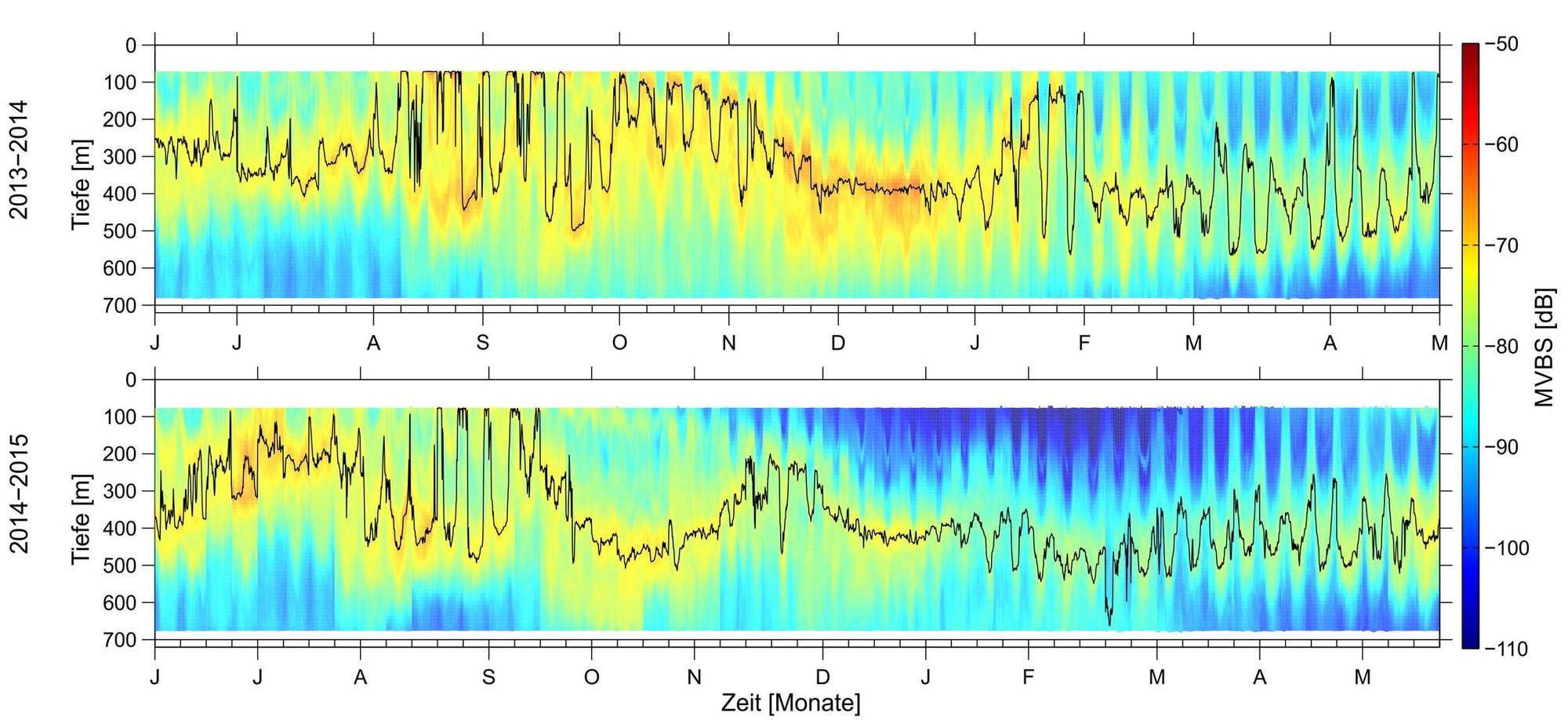
While existing coastal observatories mainly use either optical or hydroacoustic methods to study the occurrence and behaviour of certain fish species, UFOTriNet focuses on developing and testing innovative, non-invasive measurement and observation systems based on imaging opto-acoustic sensors for synchronous, high-resolution monitoring of fish and their environment. Currently, three different UFO systems exist, all combining modern acoustic and optical (pattern recognition) technologies for fish stock monitoring. The optical near-field component (close to the acoustic source, where sound waves scatter irregularly) is treated as a subsample of the acoustic far-field component (where sound waves propagate uniformly). By combining the optical and acoustic data, hybrid datasets can be generated. The biological hybrid data from acoustics and stereo optics (abundance, species identification, size measurements), together with concurrent environmental data (temperature, salinity, chlorophyll, current velocity, turbidity, etc.), provide a more complete picture of the ecosystem.
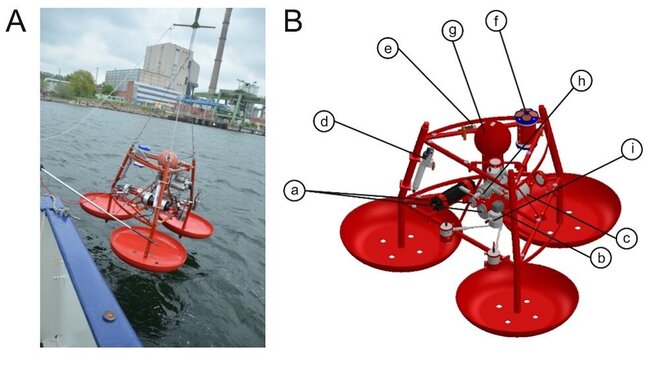
UFOTriNet thus enables continuous, long-term monitoring of fish stocks and habitats at regional hotspots. The technology we developed allows for fish stock monitoring without increased mortality among fish or other organisms. We can observe and identify individual fish and schools in relation to and along with natural or human-induced environmental changes. The biotic and abiotic time series derived from UFO data contribute to assessing climate-related changes in fish populations. Given the ecological and economic importance of coastal marine areas, there will be significant long-term scientific and societal interest in improving our ability to predict future developments in these regions, identify potential tipping points or state shifts, and develop suitable management strategies.
Links to completed UFO projects:
- UFOTriNet - sustainable fish monitoring in Kiel Bight: continuous, automated and non-invasive
- Hightech for fisheries research (AutoMAt)
Thünen-Contact
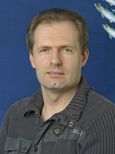
Involved Thünen-Partners
Duration
1.2015 - 12.2027
More Information
Project status:
ongoing
Publications
- 0
Wilts T, Böer G, Winkler J, Cisewski B, Schramm H, Badri-Hoeher S (2025) Descriptor : Hydroacoustic and Optical Dataset for Oceanic Research (HODOR). IEEE Data Descriptions 2:262-270, DOI:10.1109/IEEEDATA.2025.3596913
- 1
Gastauer S, Ohman MD (2025) Resolving abrupt frontal gradients in zooplankton community composition and marine snow fields with an autonomous Zooglider. Limnol Oceanogr 70(S1):S102-S120, DOI:10.1002/lno.12642
- 2
Böer G, Gröger JP, Badri-Höher S, Cisewski B, Renkewitz H, Mittermayer F, Strickmann T, Schramm H (2023) A deep-learning based pipeline for estimating the abundance and size of aquatic organisms in an unconstrained underwater environment from continuously captured stereo video. Sensors 23(6):3311, DOI:10.3390/s23063311
- 3
Hoeher PA, Zenk O, Cisewski B, Boos K, Gröger JP (2023) UVC-based biofouling suppression for long-term deployment of underwater cameras. IEEE J Ocean Eng 48(4):1389-1405, DOI:10.1109/JOE.2023.3265164
- 4
Gastauer S, Nickels CF, Ohman MD (2022) Body size- and season-dependent diel vertical migration of mesozooplankton resolved acoustically in the San Diego Trough. Limnol Oceanogr 67(2):300-313, DOI:10.1002/lno.11993
- 5
Blanluet A, Gastauer S, Cattanéo F, Goulon C, Grimardias D, Guillard J (2022) Discrimination between schools and submerged trees in reservoirs: A preliminary approach using narrowband and broadband acoustics. Can J Fish Aquat Sci 79(5):738-748, DOI:10.1139/cjfas-2021-0087
- 6
Schaber M, Gastauer S, Cisewski B, Hielscher NN, Janke M, Pena M, Sakinan S, Thorburn J (2022) Extensive oceanic mesopelagic habitat use of a migratory continental shark species. Sci Rep 12:2047, DOI:10.1038/s41598-022-05989-z
- 7
Czudaj S, Koppelmann R, Möllmann C, Schaber M, Fock HO (2021) Community structure of mesopelagic fishes constituting sound scattering layers in the eastern tropical North Atlantic. J Mar Syst 224:103635, DOI:10.1016/j.jmarsys.2021.103635
- 8
Marohn L, Schaber M, Freese M, Pohlmann J-D, Wysujack K, Czudaj S, Blancke T, Hanel R (2021) Distribution and diel vertical migration of mesopelagic fishes in the Southern Sargasso Sea - observations through hydroacoustics and stratified catches. Mar Biodiv 51:87, DOI:10.1007/s12526-021-01216-6
- 9
Bairstow F, Gastauer S, Finley LA, Edwards T, Brown CTA, Kawaguchi S, Cox MJ (2021) Improving the accuracy of krill target strength using a shape catalog. Front Mar Sci 8:658384, DOI:10.3389/fmars.2021.658384
- 10
von Appen W-J, Waite AM, Bergmann M, Bienhold C, Boebel O, Bracher A, Cisewski B, Hagemann J, Hoppema M, Iversen MH, Konrad C, Krumpen T, Lochthofen N, Metfies K, Niehoff B, Nöthig E-M, Purser A, Salter I, Schaber M, Scholz D, et al (2021) Sea-ice derived meltwater stratification slows the biological carbon pump: results from continuous observations. Nature Comm 12:7309, DOI:10.1038/s41467-021-26943-z
- 11
Burkhardt E, Opzeeland IC van, Cisewski B, Mattmüller R, Meister M, Schall E, Spiesecke S, Thomisch K, Zwicker S, Boebel O (2021) Seasonal and diel cycles of fin whale acoustic occurrence near Elephant Island, Antarctica. Royal Soc Open Sci 8:201142, DOI:10.1098/rsos.201142
- 12
Cisewski B, Hatun H, Kristiansen I, Hansen B, Larsen KMH, Eliasen SK, Jacobsen JA (2021) Vertical migration of pelagic and mesopelagic scatterers from ADCP backscatter data in the Southern Norwegian Sea. Front Mar Sci 7:542386, DOI:10.3389/fmars.2020.542386
- 13
Fischer P, Brix H, Baschek B, Kraberg AC, Brand M, Cisewski B, Riethmüller R, Breitbach G, Möller KO, Gattuso J-P, Alliouane S, van de Poll WH, Witbaard R (2020) Operating cabled underwater observatories in rough shelf-sea environments: A technological challenge. Front Mar Sci 7:551, DOI:10.3389/fmars.2020.00551
- 14
Cisewski B, Strass VH (2016) Acoustic insights into the zooplankton dynamics of the eastern Weddell Sea. Progr Oceanogr 144:42-92, DOI:10.1016/j.pocean.2016.03.005
- 15
Gastauer S, Fässler SM, O'Donnel C, Høines A, Jakbsen JA, Krysov AI, Smith L, Tangen Ø, Anthonypillai V, Mortensen E, Armstrong E, Schaber M, Scoulding B (2016) The distribution of blue whiting west of the British Isles and Ireland. Fish Res 183:32-43, DOI:10.1016/j.fishres.2016.05.012
- 16
Schulz J, Möller KO, Bracher A, Hieronymi M, Cisewski B, Barz K, Gröger JP, Stepputtis D, et al (2015) Aquatische optische Technologien in Deutschland [online]. Warnemünde: Leibniz-Institut für Ostseeforschung, 92 p, Meereswiss Ber 97, zu finden in <http://www.io-warnemuende.de/tl_files/forschung/meereswissenschaftliche-berichte/mebe97_2015-schulz.pdf> [zitiert am 15.12.2015]

![[Translate to English:] [Translate to English:]](/media/_processed_/7/1/csm_IMG_7977_large_1defaf5de1.jpg)

